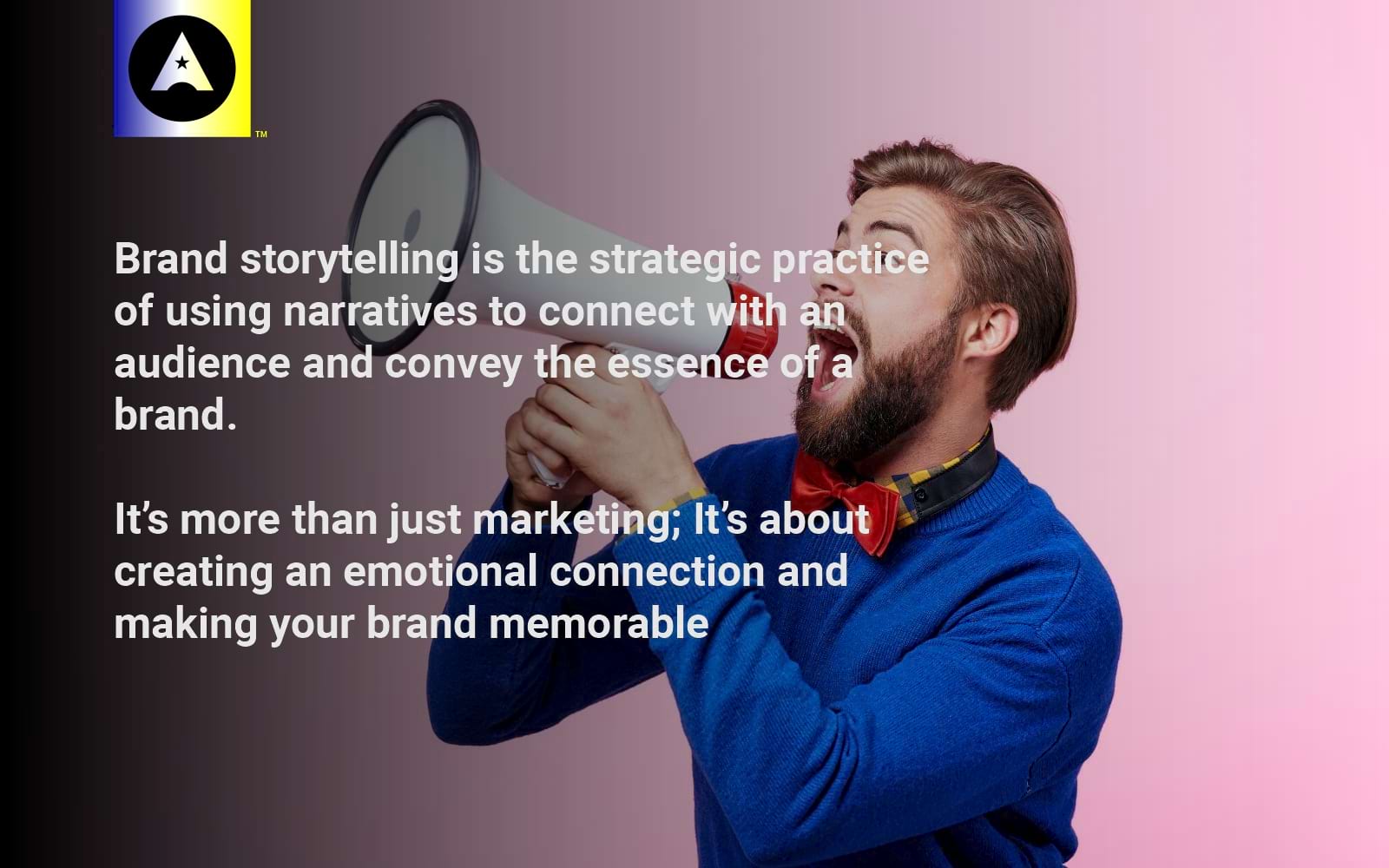Branding
Mastering The Art Of Brand Storytelling: Crafting Compelling Brand Stories
09.02.2025
By Shaikh Asif

Branding
09.02.2025
By Shaikh Asif
In today’s dynamic business landscape, where attention is scarce and competition is fierce, mastering the art of brand storytelling is no longer a luxury—it’s a necessity. Imagine having a superpower that allows you to connect deeply with your audience, foster loyalty, and build lasting relationships. That superpower is brand storytelling.

Brand storytelling is the strategic practice of using narratives to connect with an audience and convey the essence of a brand. It's more than just marketing; it’s about creating an emotional connection and making your brand memorable. At its core, brand storytelling involves communicating your brand’s values, mission, and purpose through stories that resonate with your audience on a personal level.
Brand storytelling is not just a trendy marketing tactic; it's a fundamental aspect of effective branding. In a world where consumers are bombarded with countless advertisements and marketing messages daily, a compelling brand story can make your brand stand out, foster loyalty, and drive engagement. But how exactly does a brand story matter in branding, and how does it work?
These stories can take various forms:
Brand storytelling is a powerful tactic for growing your business, and here’s why:
Relatability: Stories are relatable. When you tell a story that resonates with your audience’s desires, challenges, and aspirations, you create an emotional connection. People remember stories far better than facts or features1.
Memorability: Stories stick. A well-crafted narrative leaves a lasting impression. When your brand story is memorable, it becomes part of your audience’s mental landscape.
Emotional Impact: Stories evoke emotions. Whether it’s joy, empathy, or inspiration, emotions drive action. When people feel connected to your brand, they’re more likely to engage and become loyal customers. By telling compelling stories, brands can create a deep emotional bond with their audience, leading to loyalty and advocacy.
Differentiation: In a crowded market, a unique brand story sets you apart. It highlights what makes your brand special and why customers should choose you over competitors.
Memorability: People remember stories better than facts and figures. A well-crafted story ensures your brand stays top of mind.
Trust Building: Authentic stories build trust. They show transparency and humanize the brand, making it more relatable and trustworthy.
Engagement: Engaging stories keep audiences interested and invested in your brand. They drive higher engagement on social media, blogs, and other platforms.
Enhanced Customer Loyalty: When customers connect with your brand’s story, they are more likely to become loyal advocates.
Increased Sales: Emotional engagement through storytelling can influence purchasing decisions, leading to increased sales.
Stronger Brand Identity: Consistent storytelling reinforces your brand identity, making it recognizable and memorable.
Better Communication: Stories simplify complex information, making it easier for audiences to understand and relate to your message.
Competitive Advantage: A compelling story can be a significant differentiator in a competitive market.

Understanding Your Audience:
The first step in crafting a compelling brand story is understanding your audience. What are their needs, desires, and pain points? What motivates them? By gaining deep insights into your audience, you can create a story that resonates with them.
Defining Your Brand’s Core Message:
Your brand story should convey a clear, consistent message that aligns with your brand’s values and mission. This message serves as the foundation of your storytelling efforts, ensuring all content supports and reinforces it.
Creating a Narrative Arc:
A powerful brand story follows a narrative arc with a beginning, middle, and end. It introduces a relatable character (your customer), presents a challenge or conflict (their problem), and shows how your brand (the guide) helps them overcome it, leading to a successful resolution (the positive outcome).
Using Visual and Verbal Elements:
Effective storytelling combines visual and verbal elements. Images, videos, and graphics enhance the emotional impact of your story, while words provide context and detail. Together, they create a rich, immersive experience that engages your audience.
Ensuring Consistency Across Channels:
Consistency is key in brand storytelling. Your story should be consistently communicated across all channels, from your website and social media to advertising and customer service. This creates a cohesive brand experience that reinforces your message.
Engaging and Involving Your Audience:
Involve your audience in your story. Encourage them to share their experiences, provide feedback, and participate in your brand’s journey. User-generated content, testimonials, and social media interactions make your story more dynamic and authentic.
The first step of brand story-telling is identifying the character of your story—your customer.
Define Your Customer’s Desire or Need
Clearly define who they are and what they want. Understand their desires, needs, and aspirations. This makes your story relevant and relatable to them. For Hopebound, the primary characters are the underserved individuals and communities who need access to quality healthcare.
Example for Hopebound:
Hopebound’s target audience includes low-income families, the elderly, and individuals in remote areas who struggle to access medical services. These individuals desire affordable, compassionate healthcare that addresses their physical, emotional, and mental health needs.
Next, we need to highlight the problems and challenges faced by the character. This step is crucial as it establishes the context for why your brand exists.
Identify and Address the Challenges Your Customer Faces
Every story involves conflict. Identify the problems your customers face, both external (e.g., a need for a product) and internal (e.g., frustration or fear). This creates tension and urgency, making your story compelling. Understand the challenges your customer faces. What obstacles are in their way? How does your brand address these pain points
Example for Hopebound:
The primary problem faced by Hopebound’s audience is the lack of accessible, affordable, and holistic healthcare services. They may experience long travel times to reach medical facilities, high medical costs, and inadequate support systems for chronic conditions and mental health issues.
Understand the challenges your customer faces. What obstacles are in their way? How does your brand address these pain points

Position Your Brand as the Trusted Guide That Can Help
Your brand is not the hero; your customer is. Position your brand as the guide who has the expertise and empathy to help them. Show understanding and authority, demonstrating that you have the solution to their problems. In this step, your brand takes on the role of the guide who can help the character overcome their challenges. This involves demonstrating your expertise, empathy, and reliability.
Example for Hopebound:
Hopebound positions itself as the compassionate and knowledgeable guide, dedicated to providing comprehensive healthcare services. With a team of skilled medical professionals and a network of community support, Hopebound offers not only medical treatments but also emotional and psychological support, emphasizing a holistic approach to healing.
Who Gives Them a Plan
Outline the Steps or Process to Solve Their Problem
Provide a clear, simple plan that helps your customers overcome their challenges. This plan should outline the steps they need to take to achieve their desired outcome, making the path to success straightforward.
Example for Hopebound:
Hopebound’s plan includes the following steps:
Consultation: Initial assessment and consultation to understand the patient’s needs.
Treatment: Access to medical treatments, including regular check-ups, specialist consultations, and necessary procedures.
Support: Ongoing support services such as counseling, community programs, and follow-up care to ensure comprehensive well-being.
And Calls Them to Action: Create a Compelling Call to Action
Your story should include a clear call to action, urging the character to take the necessary steps to achieve their goals. This call to action can be direct (e.g., make an appointment) or transitional (e.g., learn more).
Example for Hopebound:
Hopebound encourages individuals to take action by scheduling a free consultation, joining a community health program, or attending health education workshops. The calls to action are designed to be accessible and inviting, emphasizing the ease and benefits of engaging with Hopebound’s services.
That Helps Them Avoid Failure: Highlight the Risks of Not Acting
Illustrate the negative consequences of inaction. By highlighting the risks and failures your customers can avoid by choosing your brand, you create a sense of urgency and motivate them to act
Example for Hopebound:
By not engaging with Hopebound, individuals risk continued health deterioration, increased medical expenses, and a lack of support in managing chronic conditions. Hopebound underscores these risks to motivate action, reinforcing the importance of timely and holistic healthcare intervention.
And Ends in Success: Describe the Positive Outcome When They Choose Your Brand
Show the transformation your customers will experience. Describe the successful outcome they will achieve by following your plan and choosing your brand. This paints a vivid picture of their potential success, making your story inspirational and motivating.
This reinforces the value of your brand and the positive impact it can have.
Example for Hopebound:
Choosing Hopebound leads to improved health outcomes, enhanced quality of life, and a supportive community that fosters healing and empowerment. Patients experience reduced stress, better management of their health conditions, and an overall sense of hope and well-being.
Brand storytelling is a powerful strategy that helps build emotional connections, differentiate your brand, and drive customer engagement and loyalty. By leveraging this practical Framework, you can craft a compelling brand story that positions your customers as the heroes, addresses their challenges, and guides them toward success. This narrative approach not only enhances your brand’s appeal but also drives tangible business results.
Using this effective Framework, Hopebound’s brand story becomes a powerful narrative that not only communicates its mission but also connects deeply with its audience. By defining the character, highlighting their problems, positioning Hopebound as the guide, offering a clear plan, calling to action, emphasizing the risks of inaction, and showcasing the success of choosing Hopebound, we create a compelling and engaging brand story.
This method of storytelling is not only effective for Hopebound but can be adapted by any organization aiming to create a meaningful and impactful brand narrative. By focusing on the needs and challenges of your audience and positioning your brand as the solution, you can build a story that resonates, motivates, and inspires action.


Shaikh Asif is an Award-winning designer, director, strategist, and educator. He’s the Lead Strategic Brand Designer and Art Director of The Alitestar— a strategic branding and design agency that helps startups, ambitious CEOs, and passionate entrepreneurs to achieve success and ultimately create unforgettable brand experiences.